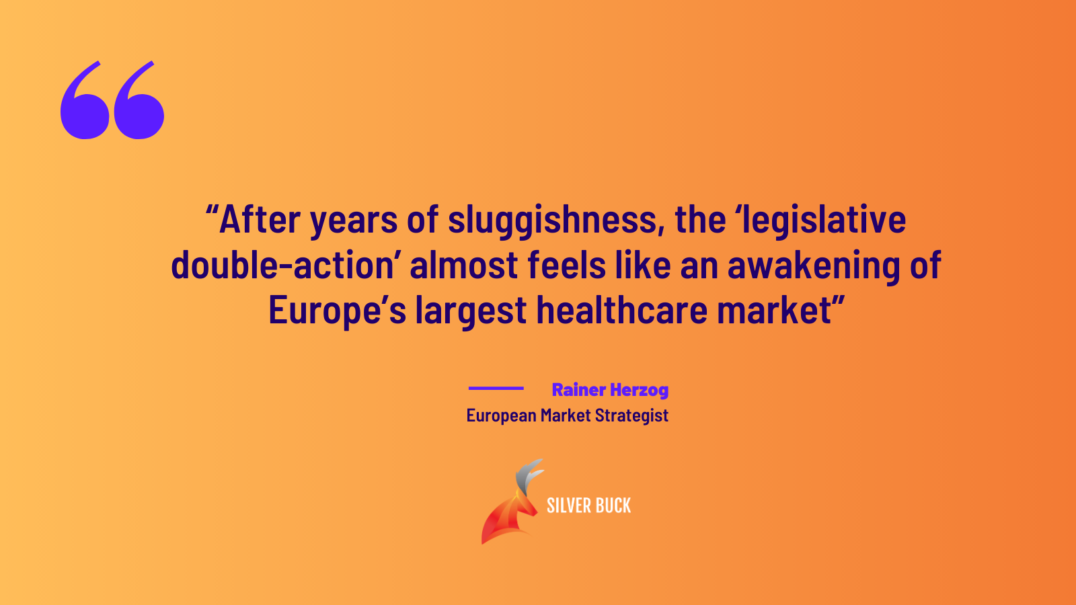Germany commits to significant investment in IT infrastructure and Digital Health
Silver Buck’s European Market Strategist, Rainer Herzog, explains Germany’s latest digital health initiative, how it works, and what it will mean for hospitals and the industry across the region.

After launching legislation on digital care in 2019 (Digitales Versorgungsgesetz – DVG), the federal government and the German member states have launched another important health innovation stimulus, Krankenhaus-Zukunftsgesetz (KHZG), which will see public hospitals across Germany receive a share of €4.3 billion from January 2021 onwards.
Unlike the DVG, which provides Electronic Patient Records to publicly insured citizens to enable prescription and reimbursement of digital health apps, the KHZGs core aim is to boost investment into IT infrastructure and digital health solutions.
But how does the new KHZG work? How can healthcare providers and their industry partners get hold of the funds? And is it enough to bring digital health alive in Germany?
KHZG – how does it work and what is it supposed to achieve?
The goal of the new legislation is to improve patient care in hospitals by modernising IT infrastructure and implementing digital tools and solutions on the basis of common international standards.
In this respect, investment projects in the following 10 domains are eligible for funding:
The 10 KHZG digital investment domains
Funding can also cover investments in qualified staff needed to implement and run the projected measures.
The new law puts great emphasis on interoperability – not only from the technical point-of-view but also with regards to building respective structures, processes and communication within and between care teams. Unless a projected measure clearly states how it will address and ensure interoperability, it has very little chance of obtaining any funding. Against this background, regional, as well as cloud-based solutions are explicitly welcome.
Hospitals receiving funding under the KHZG umbrella need to commit to accomplishing so-called “compulsory objectives” at the end of their projects. These pre-defined goals are broken down onto the different investment domains. Depending on which domains an individual funding request is addressing, the respective goals have to be attained to avoid sanctions.
In order to properly evaluate funded projects on a common basis, the Ministry of Health will publish a standardised evaluation model that measures the advancement of the digital maturity of hospitals through the projected and funded measures. The model shall be published during February 2021, and evaluations will be carried out on a self-reporting basis between June 2021 and 2023.
If the compulsory goals specified for the individual investment domains are not attained, hospitals are threatened with up to 2% cuts in turnover from 2025 onwards.
How does the KHZG application procedure work?
Hospitals can submit their projected measures until September 30 2021at the latest, and they can do so by completing a standard application form and sending it to authorities in their respective member states (Bundesländer).
What follows then, is a 2 step decision process:
- The different member states will decide on which measures to support and fund. This is done on the basis of their regional investment priorities. The member states need to take their decision within a period of maximum 3 months.
- The member states submit the resulting applications to the Federal Office for Social Security (Bundesamt für Soziale Sicherung – BAS) which then decides on the funding and distributes the grants to the member states.
As mentioned above, the projected and funded measures must be concluded by the end of 2024 to avoid hospitals being sanctioned.
Will the KHZG reach its ambitious goals?
In comparison to other European countries, hospitals in Germany are trailing behind in terms of digital maturity. Hence, a bold digital initiative is needed to prevent German hospitals from losing even more ground.
KHZG finally provides the resources to accomplish this. The big question is whether the money will really arrive at where and for what it is needed. The potentially cumbersome 2-step decision process which is prone to involve member state interests, as well as federal priorities, could prove to be the show blocker.
We have witnessed this happening with a similar digital initiative directed at the country’s educational system; a large part of these funds have still not been distributed and they, therefore, haven’t arrived at the schools where they are needed.
There are also a number of insiders who, quite rightly, ask why hospitals don’t have any say over where the money is spent. It should, therefore, be a priority for the national health ministry to closely monitor where the money is being used and distributed
What does this mean for hospitals and industry?
For many hospitals, it will be a considerable challenge to apply and get hold of funds from the KHZG, especially for the smaller and medium-sized ones. In essence, a grant application is less about technology, and more so about organisational structures, processes and ways-of-working. As digitalisation will profoundly affect and change these aspects, any successful grant application will have to properly address them. This also includes the installation of a convincing project and change management, which is going to be a challenge of its own.

As for industry, they need to move even further away from being a “solution seller” to become a “project partner”. Especially when it comes to items such as interoperability, accessibility, IT security or process modelling.
Nevertheless, the KHZG initiative will most probably break the investment stalemate in the German hospital sector and can open up significant and long-awaited business opportunities for digital health and hospital IT suppliers.

If you want to learn more about and further explore how your organization can benefit from the new German digital hospital funding initiative, please contact Rainer Herzog: rh@bauernfeind-partner.com